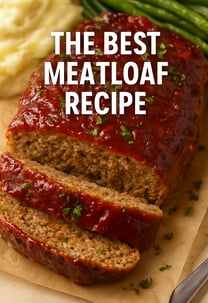Some of the links on this site are affiliate links, which means that if you click on one and make a purchase, I may earn a small commission—at no extra cost to you. This helps support the content I share and keeps this site running. I only recommend products and services I genuinely love and trust. Thank you for your support!
The Best Meatloaf Recipe: Juicy, Flavorful, and Easy!
RECIPES
5/8/20244 min read


The Timeless Appeal of Meatloaf
Meatloaf is a quintessential dish that resonates with many due to its rich history and universal appeal as a comfort food. Originally viewed as a method to stretch limited resources, the dish dates back to the medieval period and has evolved through various cultural adaptations. In America, it gained prominence during the Great Depression, serving as an economical option for families. Its practicality allowed households to use leftover meats and other ingredients, making it a staple in family dinners.
The significance of meatloaf extends beyond its economical nature; it plays a crucial role in family gatherings and nostalgic moments. Many individuals have warm memories tied to this dish, as it is often passed down through generations. The preparation of meatloaf frequently becomes a family affair, where members gather in the kitchen to mix ingredients, shaping not only the loaf itself but also fostering connections among family and friends. These shared experiences contribute to the emotional essence associated with meatloaf, reinforcing its portrayal as a comfort food.
Across various cultures, meatloaf exhibits delightful variations that highlight local ingredients and traditions. For example, in Italy, the dish is often infused with herbs and spices, while in Germany, it may be prepared with a blend of meats and served alongside hearty sides. These adaptations reveal the dish's versatility and capacity to reflect the culinary practices of different cultures, thus enhancing its status as a globally cherished meal.
Today, meatloaf remains a favored choice among many households, symbolizing warmth, comfort, and hospitality. The continued popularity can be attributed to its ability to evoke memories of home-cooked meals and family gatherings. Through its rich history and diverse interpretations, meatloaf undoubtedly stands as a timeless and beloved feature in the realm of comfort food.
Ingredients for the Perfect Meatloaf
Creating the quintessential meatloaf starts with selecting the right ingredients that contribute to the desired texture and flavor profile. At the heart of any meatloaf is ground beef, which should ideally contain a balance of both lean meat and fat. A blend with approximately 80% lean meat and 20% fat provides the moisture and richness essential for a flavorful loaf, while avoiding a dry texture. Alternatives such as ground turkey or chicken can be substituted for a lighter version, but they may require additional fat sources to maintain the classic meatloaf's juiciness.
Next, breadcrumbs serve as a binding agent and help achieve the right consistency. Different types of breadcrumbs can influence the texture; for example, plain or Italian-seasoned breadcrumbs are popular choices. Panko breadcrumbs, known for their airy and crispy texture, can be used as a variation for those who enjoy a slightly different bite. Additionally, using rolled oats as a substitute can cater to specific dietary preferences while enhancing the overall texture.
Seasoning is paramount in developing the classic meatloaf's flavor profile. A combination of minced onion, garlic powder, Worcestershire sauce, and salt enhances the richness of the meat and brings depth to the dish. Fresh herbs like parsley or thyme can also be included for a burst of freshness. Furthermore, consider incorporating ingredients like diced bell peppers or shredded carrots to add moisture and taste while also enhancing nutritional value.
For those with dietary restrictions, various substitutions can be made. Gluten-free breadcrumbs or oat flour can replace traditional breadcrumbs, making the meatloaf suitable for gluten-sensitive individuals. Yet, it is important to maintain the balance of flavors and texture while making these adjustments. By carefully selecting these ingredients and considering potential variations, anyone can create their own delightful version of classic meatloaf.
Step-by-Step Instructions to Make Meatloaf
To create a delicious classic meatloaf, beginning with the preparation is key. Start by preheating your oven to 350 degrees Fahrenheit (175 degrees Celsius). This ensures that your meatloaf bakes evenly. While the oven heats, gather all ingredients: ground beef, breadcrumbs, eggs, onion, garlic, milk, Worcestershire sauce, ketchup, salt, and pepper.
Once your oven is preheated, finely chop one medium onion and mince two cloves of garlic. In a large mixing bowl, combine these fresh ingredients with one pound of ground beef. Ensure that the beef is at room temperature for the best mixing results. Next, add one cup of breadcrumbs, one egg, half a cup of milk, and one tablespoon of Worcestershire sauce. Season with one teaspoon of salt and half a teaspoon of pepper. Using your hands or a wooden spoon, gently mix the ingredients until just combined; avoid overmixing, as this can lead to a tough meatloaf.
After mixing, transfer the mixture onto a piece of parchment paper or into a greased loaf pan. If you prefer a more traditional look, shape the meat mixture into a loaf directly on a baking sheet, keeping it about two inches thick for even cooking. Before placing the meatloaf in the oven, spread some ketchup over the top for added flavor and moisture during baking.
Now, place the meatloaf in the preheated oven and bake for 60 minutes or until a meat thermometer registers 160 degrees Fahrenheit (70 degrees Celsius) in the center of the loaf. While cooking, be sure to check for doneness with a thermometer to achieve the best results. Once cooked, remove the meatloaf from the oven and let it rest for about 10 minutes before slicing. This step helps retain its juices and ensures a moist, flavorful meatloaf that is ready to be served.
Serving Suggestions and Variations
Meatloaf is a versatile dish that can be enjoyed in numerous ways. One of the simplest accompaniments for your classic meatloaf is a side of mashed potatoes. The creamy texture of the potatoes complements the hearty meatloaf perfectly, creating a balanced meal. Furthermore, green beans sautéed with garlic or steamed in a fragrant broth can add a nice crunch and freshness to your plate. For a lighter option, consider pairing your meatloaf with a fresh garden salad. The crisp vegetables and zesty dressing offer a refreshing contrast to the richness of the meatloaf.
If you are looking to elevate your meatloaf experience, experimenting with variations can add excitement to this timeless dish. For instance, incorporating different ingredients can transform the classic recipe. Consider adding finely chopped vegetables such as bell peppers or carrots for improved texture and flavor. If you prefer a bolder taste, mixing in herbs like thyme or rosemary can enrich the overall profile of the meatloaf.
Another way to keep your meatloaf intriguing is by changing the glaze. Traditional ketchup is a popular choice, but alternatives such as barbecue sauce, teriyaki glaze, or a homemade balsamic reduction can provide a unique twist. These glazes can enhance the meatloaf, making it suitable for various palates and occasions.
When it comes to leftovers, there are countless creative avenues to explore. You can easily transform leftover meatloaf into a scrumptious sandwich, using crusty bread and your favorite toppings. Alternatively, consider crumbling the meatloaf to form a flavorful filling for tacos or shepherd's pie. By thinking outside the box, you can ensure your meatloaf remains a delicious option long after the first serving.
Discover easy recipes and handy cooking tips.
© 2025. All rights reserved.
★★★★★
